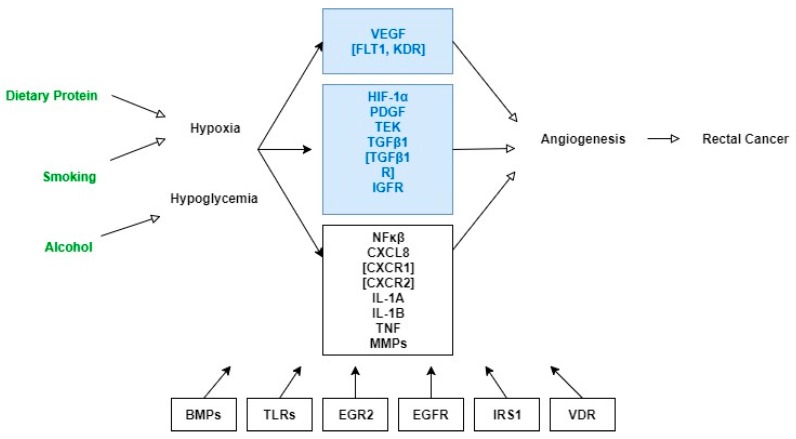Figure 1.
Working Figure of the Angiogenesis Pathway Genes. Key gene components of pathway in blue frames: VEGF = vascular endothelial growth factor; FLT1 = vascular endothelial growth factor receptor 1; KDR = vascular endothelial growth factor receptor 2; HIF-1 = hypoxia-inducible factor 1; PDGF = platelet-derived growth factor; TEK = TEK receptor tyrosine kinase; TGFβ = Transforming growth factor, beta; TGFβR = Transforming growth factor, beta receptor; IGFR = insulin-like growth factor receptor. Secondary interacting genes of pathway in black frames: NF-kB = nuclear factor of kappa light polypeptide gene enhancer in B-cells; CXCL8 = C-X-C motif chemokine ligand 8; CXCR1 = C-X-C motif chemokine receptor 1; CXCR2 = C-X-C motif chemokine receptor 2; IL-1A = interleukin-1, alpha; IL-1B = interleukin-1, beta; TNF = tumor necrosis factor; MMPs (MMP1, MMP3, MMP7, MMP9) = matrix metallopeptidases; BMPs (BMP1, BMP2, BMP4, BMPR1A, BMPR1B, BMPR2, GDF10) = bone morphogenetic proteins; TLRs (TLR2, TLR3, TLR4) = toll-like receptors; EGR2 = early growth response 2; EGFR = epidermal growth factor receptor; IRS1 = insulin receptor substrate 1; VDR = Vitamin D Receptor. Environmental factors in green text.

